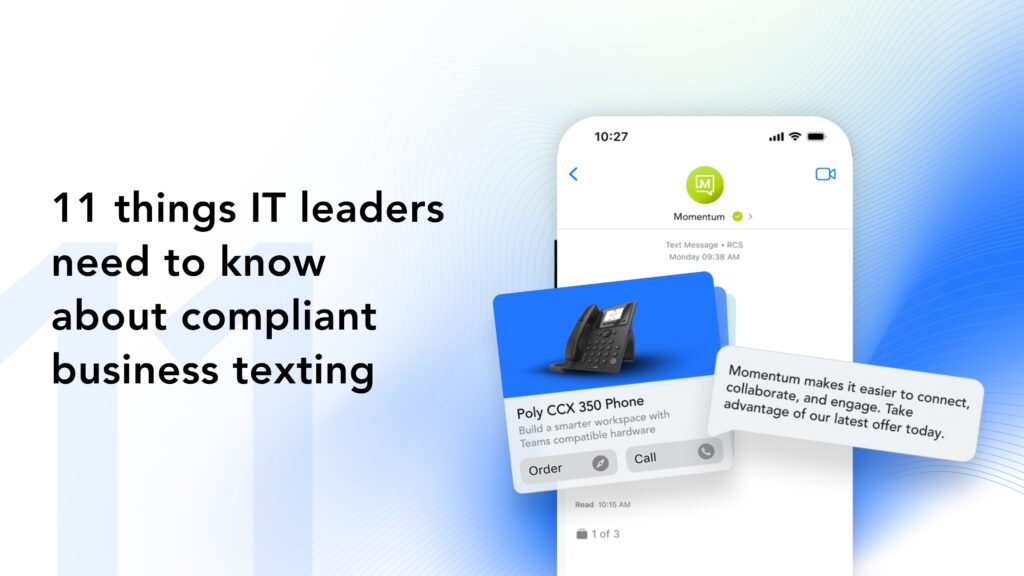You’ve likely heard the term SIP Trunking thrown around before. But you’re probably a bit confused about what it is, what it means for your business’s voice communications, and how it works.
Let’s talk about that.
We’re going to go over some of the key benefits of SIP Trunking, how it can enhance business communications, and how to choose the right service provider. Before we get too far into that, however, we’ll start by going over the basics.
What Is SIP Trunking? Understanding the Session Initiation Protocol
multimedia communication. SIP Trunking, meanwhile, uses the SIP protocol to establish and control communication connections between different users and the public switched telephone network (PSTN).
To put it another way, SIP Trunking uses SIP technology and the Internet to transmit voice packets between the PSTN and a data network. A SIP trunk eliminates the need for physical phone connections, separate wiring, and hardware. This also reduces maintenance costs and makes it easier to set up a new phone system.
SIP Trunking isn’t new. It’s been around for years already. That said, there’s still a significant embedded base of existing analog and Primary Rate Interface (PRI) lines in use.

The Benefits of SIP Trunking
SIP Trunking offers many advantages over traditional analog and PRI lines. First, it significantly reduces costs for businesses that frequently make long-distance calls. There’s also no upfront capital investment for spinning up new phone lines. This means it’s easy to scale your communications with you as your company grows.
Because there’s no unnecessary infrastructure, it’s also easier to support remote employees and connect multiple offices. Aside from enhanced cost savings and simplicity of scaling, SIP systems also offer excellent reliability.
Benefit #1: Cost Savings & Transparent Per Usage Pricing
Cost is usually the most common reason customers make the decision to move to SIP Trunking. Based on our experience, companies are often attracted to cost savings in several key areas.
Because most providers include long distance as part of their monthly recurring charge, there are no long distance charges, only international and inbound toll-free. You also only need to purchase the number of trunks you use, as opposed to PRIs, that come in 23-channel increments. Lastly, SIP Trunking uses your existing data connections, meaning there’s no need for additional phone lines.
Benefit #2: Flexibility & Ease of Scaling
One of the most significant benefits of SIP Trunking is its scalability. Once you’ve established your service, you can scale on-demand. This is a huge advantage for a growing business, as well as any business that has seasonal growth in its voice capacity requirements. It basically ensures you’ll always have enough bandwidth for your calls.
SIP Trunking is also IP based, making it easier to manage concurrent calls and call routing.
Benefit #3: Enhanced Reliability & Customized System Design
SIP Trunking also provides redundancy and reliability you don’t get with a traditional phone line or PRI. SIP traffic can easily be routed to backup connections in the event of a disruption. If you have a multisite deployment and manage multiple SIP trunks, SIP Trunking provides flexibility in how you design your network, consolidating communication channels and streamlining operations.
SIP Trunking vs. Traditional Phone Lines
SIP trunks and traditional phone lines represent two different methods for connecting a business phone system to the public telephone network. Below, we’ve listed some key differences between the two.
Cost: SIP Trunking is generally more cost-effective than traditional phone lines, especially for businesses with multiple locations or high call volumes. It eliminates the need for separate voice and data networks, reducing overall communication costs.
Scalability: Traditional phone lines aren’t designed to scale, requiring physical infrastructure and upfront capital. SIP Trunking, on the other hand, offers unparalleled scalability. Businesses can easily
Flexibility: SIP Trunking allows a business to make and receive calls from anywhere with a network connection. Traditional phone lines are tied to specific physical locations, limiting mobility.
Reliability: With a high-quality internet connection, SIP Trunking can offer superior voice quality and fewer dropped calls compared to traditional phone lines. Additionally, SIP Trunking can incorporate redundancy measures to ensure continuous service even during outages.
Features: SIP Trunking offerings often come with advanced features such as unified communications, video conferencing, and call recording.
How Can You Select the Right SIP Provider?
SIP Trunking is a popular service that’s offered by many carriers. The problem, as is so often the case, is that not all SIP Trunking providers are created equal. How do you know if you’re choosing the right vendor or evaluating a dud?
We recommend paying attention to the following:
Experience Delivering SIP Trunking
This includes managing and operating the infrastructure, provisioning services, and the operations and technology team to provide on-going support and service.
Knowledgeable Engineering, Operations, & SIP Design Teams
The engineering and operations team should have experience turning up new trunks, designing failover for both customer and network facing sessions, and number porting experience.
Geo-Redundant Network Infrastructure
The provider should operate a redundant network across multiple geographic locations, with the ability to failover to a geo-node if required. Make sure your provider also has nationwide DID coverage, and if needed, global DID reach.

911 Service & Expertise Deploying 911 Routing
Implementing and configuring your 911 system isn’t just important—it’s the law. Your provider should walk you through the process, ensuring all locations are set up properly, that 911 calls are all routing to the proper 911 authorities, and that 911 address information is presented properly.
International & Toll Free Services
Your SIP provider should be able to provide full international calling and inbound toll-free services. You should also discuss toll fraud protection with your SIP provider.
SIP/PRI Conversion
Your provider should be capable of supporting your technical requirements, such as native SIP or SIP to PRI conversion. Make sure the provider is also capable of supporting your current PBX requirements, as well.
Certifications With Major PBXs
Confirm the provider is certified with the major PBX manufacturers. Otherwise, you’ll have no way of knowing if the provider’s infrastructure and platform supports your IP PBX SIP requirements.
Experienced & Knowledgeable Support Team
Voice service is critical to the success of your business, and you need a SIP provider with an experienced support team that can provide quality and timely support when needed.
It’s also important to find a provider that’s staffed with experienced technicians so issues can get quickly resolved, targeting first call resolution.
Ancillary Services
You may need additional services in the future. Look for a SIP carrier that can provide other ancillary services, such as fax, fax to email, and even Cloud PBX services should you need to transition from your existing phone system.
Security & Toll Fraud Monitoring
Now more than ever, cybercrime is on the rise. Network hacks and toll fraud are very real and need to be monitored. If your SIP carrier provides you with international calling, you need to make sure they monitor international attempts and have alarms and/or alerts set for fraud attempts.
Pricing
SIP Trunking can provide significant cost savings when you find the right SIP carrier.
Make sure you understand the pricing model of the SIP service, including a breakdown of any fees. Standard SIP Trunking fees may include: one-time porting, monthly recurring charges for per session, per DID, per 911 DID, outbound international usage per minute, and inbound toll-free usage per minute.
Authenticity
If there’s anything you’re unsure of, don’t hesitate to ask your SIP carrier. A reputable provider will be more than happy to answer your questions. After all, they want the best outcome for your business, because your long-term success is their success too.
How Does the SIP Trunking Transition Process Work?
Once you’ve selected a vendor and decided to move forward, the last step is to start turning up your service.
The good news is that the transition to SIP Trunking is relatively painless if you’re working with an experienced company. We’ve put together a brief guide below to outline how the process should look on your end:
SIP Technology Validation: Make sure your PBX is SIP-ready and is capable of bringing in native SIP using internet protocol. And if it isn’t capable, you’ll need a plan to convert SIP to PRI.
Data Capacity Requirements: Understand your current data utilization, and if you need additional IP capacity to support your voice deployment. Voice does not use a lot of bandwidth, but if you have other applications running simultaneously with your voice, you may want to set priorities for voice to avoid quality degradation.
Firewall Configuration: Take the time to review your current firewall configuration and your SIP settings. You should check with your SIP carrier and confirm if they have standard settings for your firewall.
Redundant IP: Determine if you want to set up a redundant IP connection. If you do, coordinate with your SIP carrier so they can route to both connections. Also, if your PBX has the ability to route to multiple IP’s and the SIP carrier you select operates a geo redundant infrastructure make sure you are set up to route to each geo-redundant node.
Data Gathering Process: Next, you need to identify your current DID inventory and determine how many numbers you will be porting. You will also need to confirm information, such as your current provider and any authorized signatures on your account. You will need to validate this with your current provider and communicate it with your new SIP carrier.
Trunk Turn Up and Testing: You should supply your IP information to your service provider so they can set up new trunks and work through the testing process. Once these trunks are set up, you can begin the testing process. Temporary DIDs can be loaded so you can start testing inbound and outbound calling. The vendor should be able to assist with this process, offer feedback, and provide release reasons from the platform, so you or your IP PBX support technician can make the necessary changes to get the SIP trunks up and operational.
You may find that your individual needs go beyond these basic steps, and that’s perfectly fine. Your SIP carrier will help you build a personalized transition plan that offers minimal disruption to your organization.
Are You Looking to Transition to SIP Trunking? Momentum Can Help
Momentum is a national leader in providing cost-effective and reliable SIP Trunking services to clients in a variety of industries. Momentum’s SIP Trunking service can significantly reduce costs for businesses that frequently make international calls. From healthcare to finance, we’ve done it all.
Are you interested in learning more about Momentum’s SIP Trunking service? Get in touch today.



